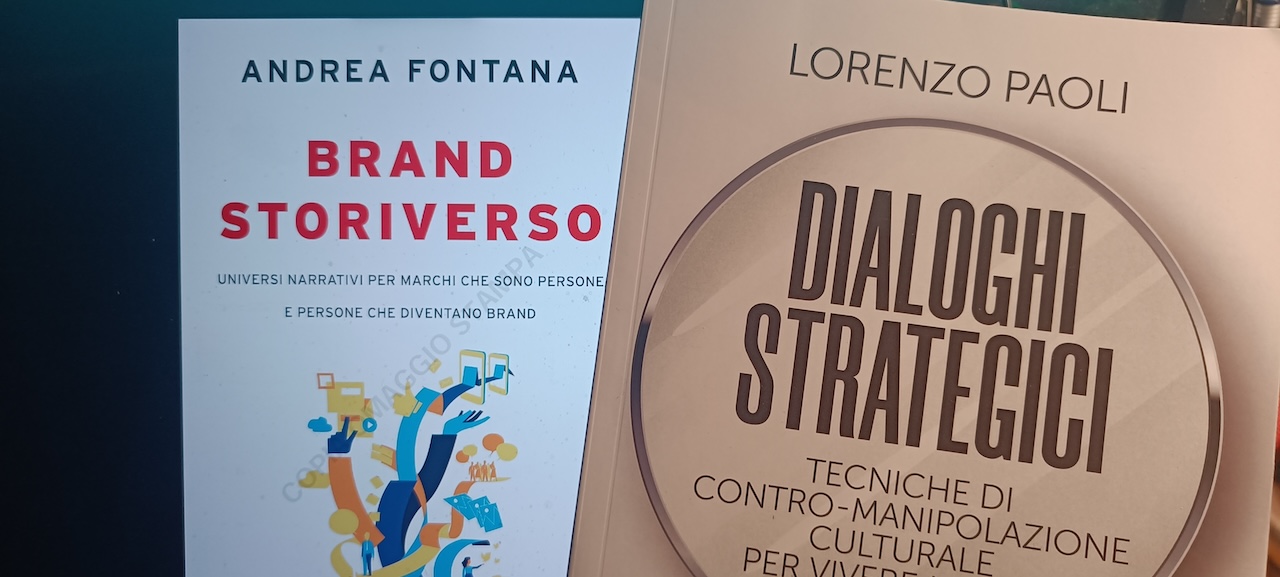Two books are the subject of this short review, the first was written by Andrea Fontana and is entitled Brand Storiverso whose subtitle is Narrative universes for brands that are people and people who become brands, the second was written by Lorenzo Paoli and has as its title Strategic Dialogues and as its subtitle Techniques of cultural counter-manipulation to live better.
Fontana’s book is published by ROI Edizioni – Business series, has 240 pages and costs 24 euros, Paoli’s is published by Ultra – Life series, has 178 pages and costs 15.9 euros.
The two books are very different from each other but they have in common the fact that they analyze, from different points of view, the relationshipbetween the singularity of each of us and our relationship with a world that recalls rules and ways of life that are often very common and similar. This is true both in the way we decide to manage ourselves and in the way we tell ourselves.
Language and storytelling
And it is precisely the story of oneself that Fontana makes the analysis starting from the idea that each of us has a narrative universe within us and it is important to learn how to express it in the best possible way.
“Every person or company has a unique and individual story to tell, a real story, which includes experiences, challenges, falls, successes that have shaped their existence. The story is now the first vector for sharing one’s biography. In recent decades, the way we tell our stories has changed considerably thanks to the spread of digital media and social networks. Platforms such as Facebook, Instagram, TikTok, Twitter (now X) offer us the possibility to create a story of ourselves through images, videos and words. We can choose to show only the most positive parts of our lives or to share the most difficult moments, based on how we want to be perceived by others. But we can’t avoid telling our stories with an incessant flow. The constant telling of ourselves thus creates our own story, personal or corporate. This story is us in our narrative quintessence and telling it is an act of courage and beauty, as well as of human sensitivity,” says Fontana in a note that accompanies the book and adds: “Because only when we are able to better narrate our story, to attribute meaning to it and to understand its common threads, We can really fully know our story and spread it effectively. And only when we are able to share our story with others, can we build bridges, create empathy and make connections.”
The sociologist author of the book and a profound connoisseur of storytelling starts from real and concrete cases by analyzing brands such as Amazon, Jeep, Lego, Plasmon, Coca Cola, Barilla and many others and builds valid examples of how you can make self-narration a tool of strength to grow and reach your audience. Examples that serve to better understand which tools to use and which, of course, are valid both for large companies but also for startups and of course are also declined when the subject of the story is ourselves.
Paoli, who deals with strategic communication, also starts from the idea of storytelling as a tool to make both our story and the ability to make decisions and build relationships more effective. Cognitive linguistics is the basic concept that the author develops in four chapters: dialogues on being, dialogues on the problem, dialogues on decisions and dialogues on acting.
Two texts in which everyone can find their own interpretation, and possibly use them as a starting point to improve the way in which we tell our stories and interact, are books to be considered as a sort of toolbox from which to take what we consider most useful and in all cases harbingers of ideas and analyses that can help us to make those reflections of rationalization that often escape even when we are talking about them. They do things well but you are not fully aware of their potential effectiveness.
ALL RIGHTS RESERVED ©
